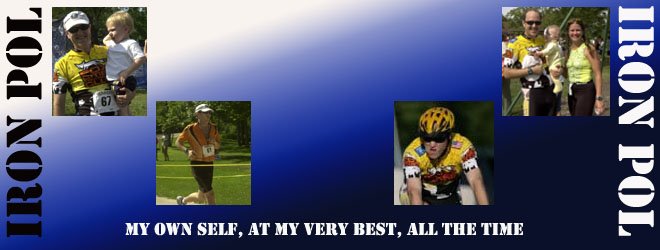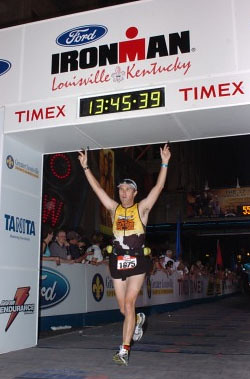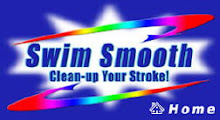Swim. Bike. Run. Nutrition? It is said that nutrition is the fourth discipline of triathlon, and in few races is that so visible as it is in Ironman. The time spent completing an IM distance race makes proper nutrition a necessity.
For many, it is also the most difficult discipline. And for first timers, it is admittedly a crapshoot. While we use long training sessions and other races as test cases for what to do on IM race day, it is impossible to simulate the magnitude of completing an Ironman. It must be done.
Reading some of the race reports, I'm getting a better feel for the challenges that may develop on August 26th in Louisville. Those under Coach Mike's tutelage got an advance copy of his race report from Ironman Arizona. It is quite obvious from his report that nutrition can quickly overshadow just about any other challenge.
Mike commented about difficulties staying on course in the swim for two major issues. First, his goggles were leaking and kept filling up with water. Second, he apparently lost a contact somewhere along the way. Those two issues combined to cause Mike to miss his swim goal (of 57:30), by a WHOLE three minutes. (Just for the record, leaky goggles would slow me down a WHOLE lot more).
The wind in Arizona was another huge factor. Particularly on the bike. Mike has set a bike goal of 5:20, an aggressive 10 minutes faster than his previous best bike. Despite the conditions, Mike finished in 5:35, his third best bike time in an IM race.
But Mike's own comments touch on the fourth discipline of triathlon. The balance between caloric intake, hydration, and power output is very fine, indeed. The simple difference of a bit of water can have a huge impact on a race. In this case, Mike indicated that his solid food intake called for more fluids than he was able to get his hands on. As food became less palatable, his caloric intake fell, and power went with it. By the end of the bike, he knew that the run would be a struggle. To his credit, Mike ponied up and completed the race. Again, for the record, while short of his target marathon time, Mike's sub-4:30 marathon is very impressive.
Nutrition has always been more of an afterthought, for me. Throw a few gels into the running pack. Water, Gatorade? Whatever's handy. Going for a bike? Grab a Clif Bar or a banana. Get a couple bottles of whatever's available and get out the door. Forget everything? No biggie, even a marathon can be completed on just water or Gatorade.
That mentality? Well, it's just got to go. That kind of thinking will earn me a bed right next to Commodore. Only I'll have nothing to blame except myself. So, it's time for some research, and you can all add your two cents worth.
As a marathoner, I'm used to gels (I use Gu) and Gatorade. On long rides, I've been carrying Clif Bars, Gatorade, and water. Mike's comments hinted that purely liquid calories may be a better option. The question will come down to what will meet my needs on race day. If I can handle solid food, am I better off with that? Or am I better off going all liquid for ease?
One thing is certain. I have less than 100 days to sort it out, because after that, I won't have time to test things out. And after my first triathlon, I learned not to use ANYTHING new on race day.
*Side note* While looking for the post on my first triathlon, I came across the post about my first mile swim. Two things caught my eye. First, my feelings about a 1760 yard swim at that time. I called it a miracle mile. Second, the pace I mentioned, 2:45/100 yards. Less than 12 months later, a 2000 yard swim is an easy session. And if I see 2:45, I know I forgot to hit my lap counter.
Subscribe to:
Post Comments (Atom)











12 comments:
Personally, I'm just starting to understand my needs for long sessions and have yet to put them to the test under racing conditions beyond an oly. But I'm learning interesting things about my body. For instance, even though Perpetuem tastes kinda gross, it hugely impacts my ability to recover. Topping off the tanks the night before a race? Mint chocolate chip ice cream. No joke. And I have to have solids to avoid stomach cramping, regardless of how much I love GU.
I guess everyone is different, but it's impossible to make it through the *training* for an iron distance without learning an awful lot about how you burn calories and how you digest calories.
i don't have a clue. but i really like accelerade for my biking days. i, personally, can't use it when i run cuz the jossling around in my tummy does a number, but..
i dunno. thats all i could think of. (its a carb-protein mix. me likey.)
what else...
a bunch of my iron-friends use cytomax? 0% chick swears by it. actually they all do. so maybe take a look into that.
Pol I love your blog because you sort of take any problem I am having/worrying about and put it out there in a comphrensive and eloquent way. So I don't even have to think :)
The Nothing New On Race Day (NNRD?) is an old adage that's been beat into me from years of marathons.
Between the countdown clock and all of my worries about nurtition, you have me pinned this week. I have not been officially doing anything but clif bars and bananas during my long rides (2 1/2 to 3 hours) so far. For running a couple of Gus and I am good...but everyone I keep talking to keeps telling me to call Hammer Nutrition and have them help me with putting together a liquid plan. So, I probably should do that!
Keep on moving forward!
Laura
The nutrition piece also has me concerned. I can't stand gels; make me want to puke. I am using Sustained Energy from Hammer and Nuun for electrolyte replacement. I have greatly increased my fluid intake in general. I try to take a swallow every 10 min. I know for myself if I don't put a time limit on my nutrition intake, I tend to blow it off. I want to try to incorporate a few solids into my long rides because all the sweet liquids get a bit sickening as well. The nutrition game plan is tough especially for us first time IMers.
Nutrition is definitely the 4th discipline. Even with drinking 3 gallons of plain water and 1,750 liquid calories I still lost 20 pounds and suffered severe dehydration. Being sick the week before did not help obviously.
Its important to have a nutri. plan for the race but be prepared to "Go Native" on the course. Learn to use flat coke, learn to drink gatorade, and eat oranges on the bike. Choke down vanilla and latte flavored gels b/c thats what your going to get out there.
That nutrition part can be tough to get right...and each race, your needs can change. There are always the sure bets, but the rest is trial and error.
I'm definitely not one to ask about nutrition. I'm the one who stopped eating gu at my marathon, only to figure out that I probably shouldn't have given it up by mile 20.
Say, that didn't happen to be you in my store last week, buying six boxes of chocolate gu, in preparation for IM Louisville, was it?
Well, as you probably know, I never got to execute my nutrition plan in full on race day but I did attend an IMFL training camp where they talked about nutrition and recommended Carbo Pro. The liquid carbs worked well for me on my 10 and 12-hour mock IM workouts, which I did primarily to test the nutrition and mental part of my training. In fact, I'm planning to use it for my HIM races too this year since I'm sure poor nutrition, along with too hard a bike, made my run miserable during last year's HIM.
BTW, way to go finishing your first sprint!
I am going to have to dig up my old post on this but here's my two cents...
Keep it simple.
Eat at least 1,000 calories before you go to bed the night before the race. You'll digest some of this while you sleep so to be sure to top off your calories with a breakfast that you're used to eating before you swim. Pop a gel as soon as the gun goes off to start the swim. This ensures you have all the calories you can hold before the swim. You'll need these to burn on the swim. At a 2:00 per 100 yard pace, you'll probably deplete these available calories before the swim is over, so contrary to conventional wisdom, pop a gel in T1. You risk a chance of this upsetting your stomach, but you don't want to start the bike on Empty, especially since conventional wisdom also tells you to not eat for the first x-number of minutes on the bike. On the other hand, if you finish the swim in a hour or so, don't bother eating in T1.
For the bike, Liquid Nutrition is great for keeping it simple. Cram 6 hours worth of fuel into the two bike bottles that attach to your frame. Divide your bike bottles into 1/3's with a fat black marker. Keep an extra hours worth of fuel in a bottle stored in your special needs bag. This gives you 7 total hours of fuel and quite honestly, if you're on the bike longer than 7 hours, you've got other problems... seriously. 1/2 hour into the bike, drink your first portion (this ensures you don't burn off tht first gel before your fueling). Wash it down with water only. Only put water in your aero bottle, since you have all the calories you need in the fuel in your bike bottles. PLUS... water is always available on the course... your favorite flavor of Gatorade may not be. I would also like to add here that I trained with Gatorade Endurance formula and I'm pretty damned sure that what they served on the bike and run course wasn't Gatorade Endurance. Sip only water for the next hour (1:30 into the bike) and then drink your second portion as marked on your bottle with the black marker. To me, this is truly the best strategy for fueling on the bike because 1) You don't have to carry any fuel on your person, which means less weight and no packages to open on the bike (i'm not that coordinated so this was important to me) and 2) You don't have to remember how much to drink, just drink to the next line marked on your bottle, and most importantly 3) You only have to remember to fuel six times + special needs if necessary, compared to the 36+ times someone would have to fuel on the conventional wisdom of taking something in every 10 minutes. Truth be told, I almost forgot to drink one of my six times. God knows what would have happened if I tried to remember something 36 times...
For the run... if you started fueling on the bike 30 minutes in, then every hour after that, whether you finish in 6 or 7 hours (assuming you had that extra hours worth of fuel in your Special Needs Bag) you will have enough fuel to carry you through T2 and into at least the first 30 minutes of the run. This allows you to get through T2 quickly without dilly-dallying. The longer you take in T2, the harder it will be to get going.
Use gels only on the run, coke and soup if necessary. Only sample as a means of getting from aid station to aid station, ie, promise yourself you'll have a coke at the next aid station, but not this one...
Knowing what I know now, that's how I WOULD have done IM Florida.
My two cents... hope it gives you some ideas.
the more food you take in...the more likely GI distress will occur. so many pros will figure out exactly how much they can take in where they are gaining no marginal returns from their food. this is what i was taught anyway.
side note: i noticed you are doing high cliff and spirit of racine. well so am i. i'll see you out there
Iron Pol,
That's my major concern for my first Ironman.
I have yet to narrow down how much calorie I need. It is still in the tinkering mode. For the past few months, i was taking way too much sodium and i have major GI issues. If it happens on race day, it will be a very very long day.
My coach suggest me to rotate between liquid and solid food hourly on the bike. This way, when I am on the run, I won't be sick of sipping liquid for 6+ hours.
Post a Comment